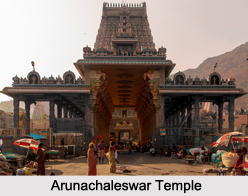 Tiruvannamalai is the home of Annamalayaar or Arunachaleswarar (Shiva worshipped as a Shiva Lingam) and Unnamulaiyaal (Apitakuchambaal - Parvati), and is one of the largest temples in India. It is regarded as Pancha Bhoota Stalams and is one of the grand temples associated with the five elements. This is associated with Fire, the other four being Tiruvanaikkaval (Water), Chidambaram (Space), Kanchipuram (Earth) and Sri Kalahasti (Wind) respectively. Shiva manifests here as a massive column of fire. Antiquity: The town has been associated with yogis. The temple dates back a thousand years. A 7th century poem glorifies this temple.
Tiruvannamalai is the home of Annamalayaar or Arunachaleswarar (Shiva worshipped as a Shiva Lingam) and Unnamulaiyaal (Apitakuchambaal - Parvati), and is one of the largest temples in India. It is regarded as Pancha Bhoota Stalams and is one of the grand temples associated with the five elements. This is associated with Fire, the other four being Tiruvanaikkaval (Water), Chidambaram (Space), Kanchipuram (Earth) and Sri Kalahasti (Wind) respectively. Shiva manifests here as a massive column of fire. Antiquity: The town has been associated with yogis. The temple dates back a thousand years. A 7th century poem glorifies this temple.
The temple is the result of building down the centuries via building, alteration and extension. A Nandi faces the main shrine in each of its five prakarams.The outermost houses the 1000 pillared hall and the Shiva Ganga tank that has four sides with gopurams. The fourth prakaram includes the Bhramma Tirtham, and the eastern gateway - Vallala Gopuram has a statue of King Ballala. The third prakaram dates back to the 12th century and has several linga Shrines, and the Kili Gopura entrance. On the East side of the prakaram stands the Flag Staff, the North side is home to the shrine of Unnamulai Amman. The third prakaram goes around the second prakaram which houses the deities associated with Shiva, and surrounds the shrine of Annamalaiyar.
Elaborate worship marks each day at the temple. The day begins with the ceremonial arrival of Ganga to the shrine, from a tank in the Southern part of the town on an elephant. The next ritual involves waking up Shiva and Parvati. The Shiva-Meru returns to the Annamalaiyaar shrine while the image of Parvati returns to the Unnamulaiamman shrine. Six other pujas are offered at the temple. Each service is accompanied by chants of invocation, dedication and praise.
Festivals: Several festivals mark the calender. The festivals of the temple are remarkably intertwined with the life of the locals.





















